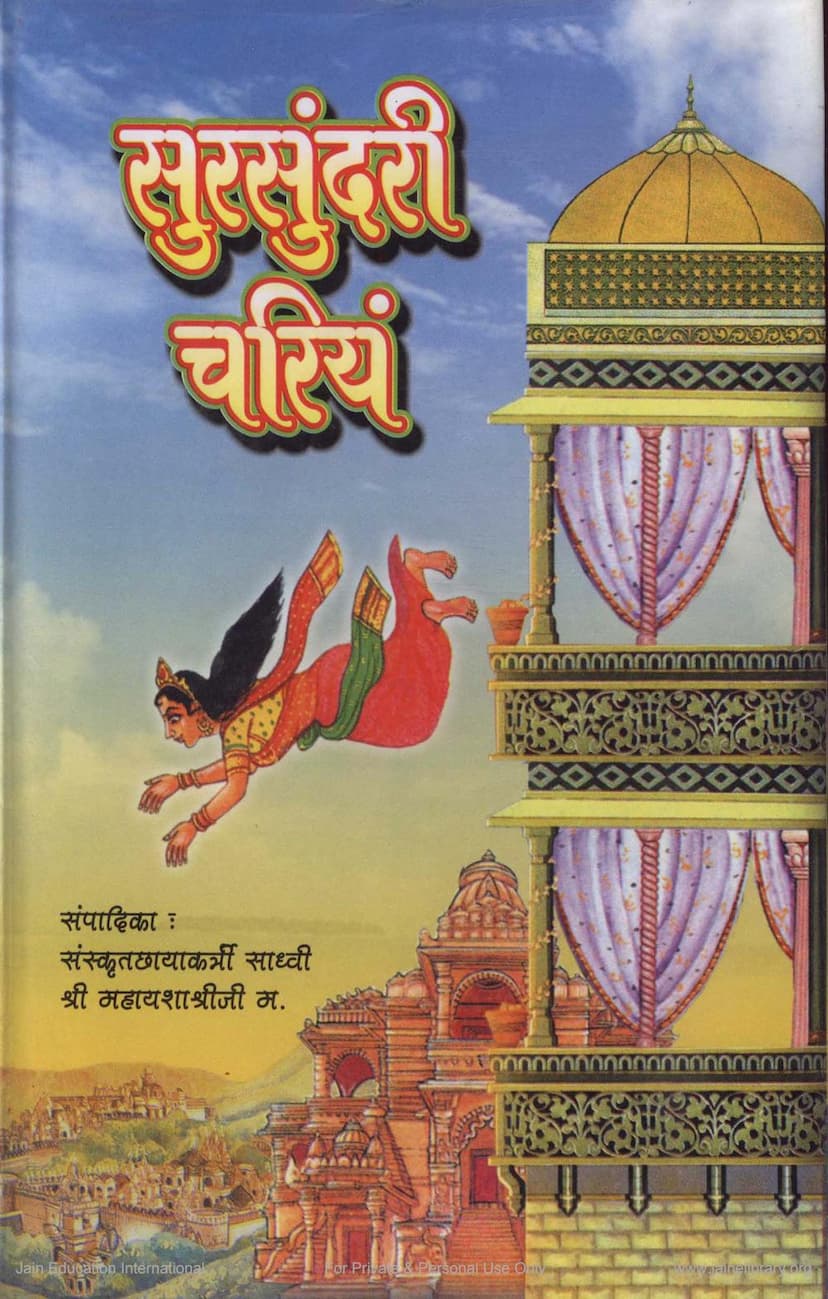Sursundari Chariyam
Added to library: September 2, 2025

Summary
Here's a comprehensive summary of the Jain text "Sursundari Chariyam" by Dhaneshwarmuni, edited by Sadhvi Shree Mahayashashriji:
Title: Sursundari Chariyam (सुरसुंदरी चरिय) Author: Dhaneshwarmuni (सिरिधणेसरमुणीसरविरइयं) Editor & Sanskrit Translator: Sadhvi Shree Mahayashashriji (साध्वी श्री महायशाश्रीजी म.) Publisher: Omkar Gyanmandir, Surat (आ. श्री ॐकारसूरीश्वरजी ज्ञानमंदिर) Catalog Link: https://jainqq.org/explore/001884/1
Overall Summary:
The "Sursundari Chariyam" is a Prakrit kavya (poetic narrative) composed by the revered Jain Muni Dhaneshwar in 1095 Vikram Samvat (approximately 1038 CE) in Chandravati. This work is a significant contribution to Jain literature, particularly for its narrative of Sursundari, a virtuous heroine, and its exploration of Jain ethical and philosophical principles through a captivating story. The book has been meticulously edited and presented with a Sanskrit translation (Chhayā) by Sadhvi Shree Mahayashashriji, making it accessible to a wider audience, especially Prakrit scholars and those interested in Jain narratives.
Key Aspects and Themes:
-
Narrative Structure: The text is a detailed biography or narrative (Chariyam) focusing on the life and spiritual journey of Sursundari. The story is structured into sixteen chapters (Parichheda), each likely detailing different phases of her life, her spiritual evolution, and the events that shaped her destiny. The author, Dhaneshwar Muni, explicitly mentions his intention to present a story that inspires contemplation and virtue.
-
Heroine's Character: While the title highlights Sursundari, the narrative begins with the lineage and context of King Amarketu of Hastinapur, setting the stage for the story. The specific details of Sursundari's life, her virtues, challenges, and spiritual development are explored throughout the text, underscoring the Jain ideals of righteousness, detachment, and the pursuit of liberation.
-
Language and Translation: The original work is in Prakrit, a language prevalent in ancient India and used extensively in Jain scriptures. The inclusion of a Sanskrit translation (Chhayā) is crucial for understanding the nuances of the Prakrit text, especially for readers who may not be fluent in ancient Prakrit. Sadhvi Mahayashashriji's expertise in Prakrit and Sanskrit is highlighted as instrumental in making this valuable text accessible.
-
Author's Intent and Tradition: Dhaneshwar Muni is presented as a significant figure in Jain literature, belonging to a lineage of scholars and saints. The text reflects the rich tradition of Jain storytelling, which often uses narratives to impart moral and spiritual lessons. The author's self-reference at the end of chapters ("Sahu Thalsar vir") and in the final praise confirms his identity as Muni Dhaneswar.
-
Scholarly Contribution: The inclusion of Sūrasundari Chariyam in academic curricula, such as in Mumbai University, indicates its literary and educational value. The summary also mentions various earlier works and translations based on this story, pointing to its enduring popularity and influence. Scholars like Prof. Hiralal Kapadia have also noted Dhaneshwar Muni's connection to Jinbhadra Suri, suggesting a potential historical link or scholarly tradition.
-
Artistic and Literary Merit: The text is praised for its literary qualities, including a coherent narrative flow, appropriate descriptions, and the use of various poetic devices like upama (simile), shlesh (pun), and rupak (metaphor). Scholars like Dr. Nemichandra Shastri and Dr. Jagdishchandra Jain have lauded the kavya for its richness in emotions (rasa), particularly the tranquil (shanta) rasa, its insightful portrayal of worldly struggles, vivid nature descriptions, and philosophical and ethical underpinnings.
-
Publisher's and Editor's Dedication: The publication is dedicated to the revered Muni Shree Chandrayashvijayji M.S., acknowledging his spiritual and devotional life. The publisher expresses gratitude to Shri Bhiladiji Parshwanath Jain Tirth Pedhi and Shri Oswal Panchmahaljan-Padiv for their financial support, emphasizing the collaborative effort in bringing this work to light. The editor, Sadhvi Mahayashashriji, expresses her gratitude to her gurus and acknowledges their guidance, highlighting the importance of making Prakrit literature accessible for study and spiritual upliftment.
-
Content (from Table of Contents): The extensive table of contents reveals a narrative filled with diverse episodes:
- Chapter 1: Introduction, praise of virtues and vices, author's intention, description of the land and King Amarketu, introduction of the painter, the painting of the princess, the king's infatuation, inquiries about the princess, and the merchant Dhan Dev.
- Subsequent Chapters: Detail adventures involving bandits, Vidhyadhar kings (like Chitravega), love stories (Makar Ketu and Sursundari, Chitravega and Kanakmala), journeys (sea voyages), battles, religious discourses, the lives of various characters across different lifetimes, spiritual insights, and eventual liberation (moksha). The narrative weaves together secular love stories with Jain ethical teachings and the concept of karma.
In essence, "Sursundari Chariyam" is a traditional Jain narrative that uses the story of its titular heroine and associated characters to illustrate Jain principles, karma, reincarnation, and the ultimate goal of spiritual liberation, all presented with considerable literary skill and scholarly commentary.